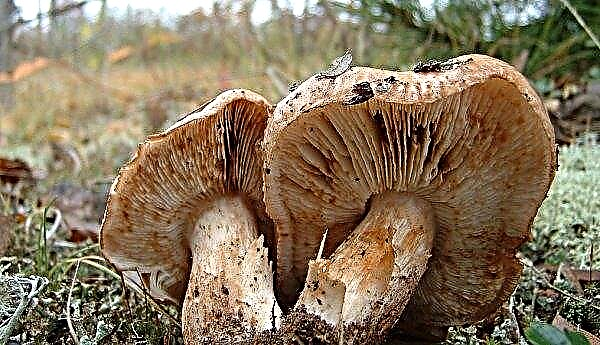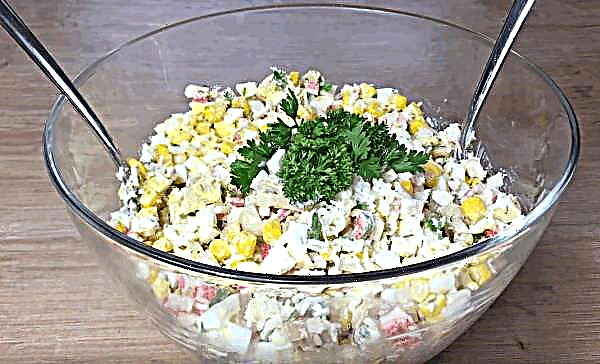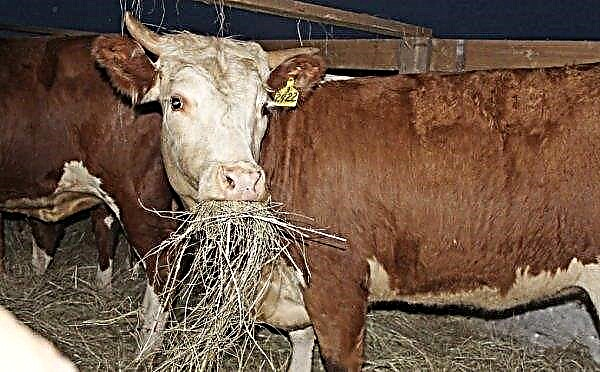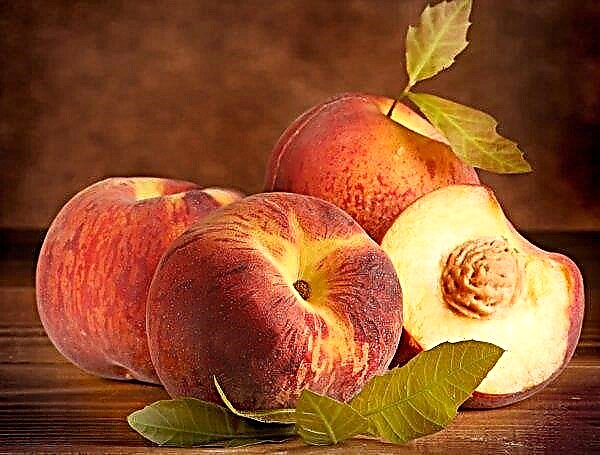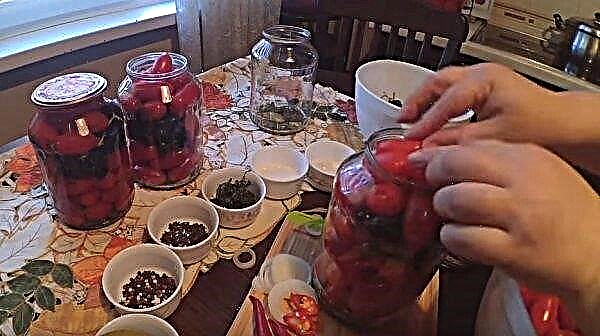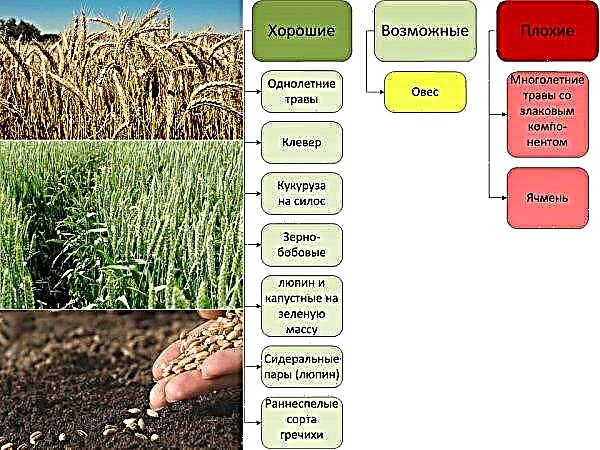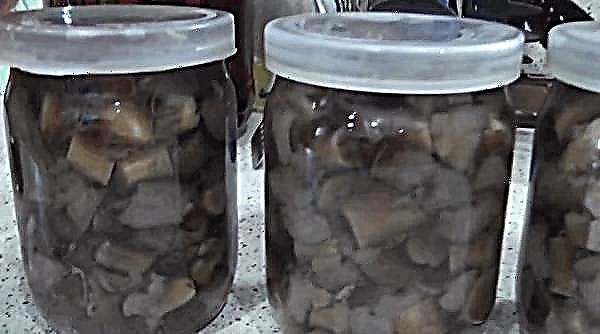The hybrid Trilogy F1 variety began to take on increasing popularity among gardeners growing cucumbers due to the presence of good indicators. He will be discussed further.
Selection History and Variety Description
The Trilogy variety was bred by the Dutch breeders from the company Raik Zvaan, and in 2011 it was added to the state register of the Russian Federation for the Central and North-Western region. Belongs to early ripening varieties grown in open areas. Fruits ripen in 50–58 days after planting seedlings in the ground. A distinctive feature is the ability to self-pollinate without the help of insects.
Important! Most cucumbers form in the first month of fruiting, which must be taken into account when fertilizing.
Bushes are formed with long branches, with the main stem giving the main crop. The flowers are female, appear in large numbers. The fruits are cylindrical, 8-10 cm long, dark green in color with light side stripes and thin skin. A bit rough and have light spikes. The weight of one cucumber averages 65–100 g. The pulp is juicy, crunchy, without bitterness.

Advantages and disadvantages of the variety
- The positive properties of cucumber Trilogy F1 include:
- excellent taste;
- immunity to temperature extremes;
- sufficiently high productivity;
- resistance to diseases;
- versatility in cooking;
- good presentation and excellent endurance during transportation;
- cucumbers ripen at the same time.
- The disadvantages are:
- instability to peronosporosis;
- the need for garter to the support.
Planting and growing varieties
Trilogy can be grown in two ways:
- sow seeds immediately in the garden - does not require prior care, but when the temperature drops below + 5 ° C, seedlings can die;
- using seedlings - provides greater survival of seedlings, but there is a risk of overgrowing seedlings, which is not suitable for planting in the ground.
Seed directly into the ground
Sowing seeds in open ground is carried out in the second half of May - early June, when the soil warms up to +15 ... + 17 ° C to a depth of 3-4 cm. Before this, the seed must be germinated for better germination. Seeds are sown at a distance of 40 cm from each other, between the rows leave a distance of 60 cm. The place for the beds is chosen sunny, isolated from wind and drafts.
Seeds are sown at a distance of 40 cm from each other, between the rows leave a distance of 60 cm. The place for the beds is chosen sunny, isolated from wind and drafts.
You can also plant corn around the perimeter. The soil should be sandy loam or slightly loamy, dug to a depth of 10 cm, fertilized with organic and mineral fertilizers. It is recommended to grow F1 Trilogy cucumbers after legumes, tomatoes, peppers, cabbage, onions, and away from crops that require insect pollination.
Growing seedlings
For seedlings, seed is sown a month before planting it in open ground.
Did you know? To maintain her beauty Cleopatra ate cucumbers almost every day.
Experts advise:
- Use not boxes, but separate cassettes or cups, peat tablets are best.
- Apply peat land.
- Plant seeds to a depth of 1-2 cm.
- Pour with a spray bottle.
- Cover with transparent glass or film.
- Put in a warm place at a temperature of + 25 ° C until germination of seedlings.
- Once a week, pour warm, settled water.
- After the first 2 sheets appear, open the seedlings and put them in place with diffused lighting, which should last up to 10 hours.
- The temperature should be maintained during the day +22 ... + 23 ° С, at night - +16 ... + 19 ° С.
- The first top dressing under the root should be carried out in 2–2.5 weeks after the emergence of sprouts with fertilizers “Fertility” (1 tbsp.spoon per 10 l of water), “Nursery” (1 tbsp.spoon per 10 l of water), etc. The next - after the appearance second adult sheet, mixing 1 tbsp. teaspoon of wood ash, 1 teaspoon of nitrophoska, 3 l of water. The latter - 2-3 days before planting on the bed, soaking dry, raw yeast or brown bread in water. All dressings are consumed with the calculation of 1 glass per 1 seedling.
- Grow until the appearance of 4-5 permanent leaves.

Variety Care Features
Caring for seedlings planted in open ground includes an irrigation regime, applying fertilizers, tying bushes to a support, weeding, loosening the soil, and combating diseases and pests.
Also pay attention to the characteristics of other self-pollinated varieties of cucumbers:
Watering
Watering the plants must be plentifully with warm, settled water every 3-4 days, and during flowering and ripening of the fruits, increase watering.
Fertilizer application
Fertilizers are applied every 2 weeks, and it is advisable to alternate organic fertilizers with mineral ones, which should easily dissolve in water, given the weak root system of this variety of cucumbers. Feeding should be greater in the first month of fruiting, since during this period the plants give the greatest yield.
Important! Feeding is preferably carried out in the evening or on a cloudy time of the day after heavy watering.
It consists in the following:
- the first fertilizer - carried out 2 weeks after planting on the bed with a mixture of 1 tbsp. tablespoons of urea, 60 g of superphosphate and 10 l of water or slurry in a ratio of 1: 8;
- the second is carried out during flowering using 2 tbsp. tablespoons of superphosphate per 10 liters of water or 1 cup of wood ash per 10 liters of water;
- the third - is introduced during fruiting 50 g of urea per 10 liters of water or infusion of grass in a ratio of 1: 5;
- the fourth - after 2 weeks: 1 tbsp. a spoon of drinking soda in 10 liters of water or a two-day infusion of pre-ripened hay.
Garter and bush formation

The variety of cucumbers Trilogy F1 requires a garter of the central stem to the horizontal support, and all the side stepsons must be removed and the ovaries left. At a height of 40-50 cm from the ground level, not only the side shoots, but also the ovaries are removed.
After the main stalk reaches to the support, it is wrapped around it and tied after 50-100 cm.On the intervals, 2-3 side shoots at the nodes are left. Saved shoots of the 1st and 2nd order pinch after the 4th leaf. The number of fruits can be set independently and individually, given the condition of the bushes.
Soil care
A prerequisite in the cultivation of cucumbers is regular soil care. It includes constant weeding from weeds, due to which fungal diseases can occur, loosening of the earth after irrigation and rain, providing plant roots with oxygen access, as well as mulching with sawdust, straw, peat, with the help of which moisture is held in the ground with nutrients, and weed growth is also reduced.

Grade Diseases and Pests
This hybrid variety is resistant to major diseases and for preventive purposes requires proper care, timely destruction of weeds, sanitary processing of inventory, and avoidance of proximity to pumpkin crops. But it has a weak immunity to peronosporosis or downy mildew, which is manifested by the appearance of light yellow spots on the leaves, eventually merging and affecting large areas of plants.
You can fight this fungal disease by destroying diseased bushes, and also using drugs such as a 0.5% solution of Bordeaux mixture, Ridomil (25 g per 5 l of water), Kurzat (30 g per 10 l of water) . The main pests of the Trilogy F1 variety include spider mites, aphids, and thrips. Effective means against them are Actellik (2 ml per 2 liters of water), Talstar (24 ml per 1 hundred parts), Actofit (8-10 ml per 1 liter of water).
Did you know? There is a mad cucumber that throws its seeds in a jet movement.
Features of harvesting and storage of crops
Since F1 Trilogy cucumbers ripen almost simultaneously, it is recommended to harvest the crop every other day.

The requirements for long-term storage of vegetables are as follows:
- it is best to keep the fruits in a cool, dry cellar at a temperature of +4 ... 0 ° C, so they last up to 28 days;
- avoid temperature extremes;
- take away fruits fresh, whole, without damage and signs of decay;
- put cucumbers in boxes and sprinkle with sand.

